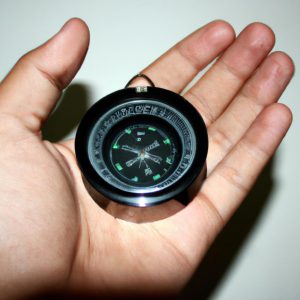Magnetism: The Magnetic Moment in Physics

Magnetism, a fundamental force of nature, is an intriguing phenomenon that has captivated the attention and curiosity of scientists for centuries. From compass needles aligning with Earth’s magnetic field to MRI machines enabling us to peer inside the human body, magnetism plays a significant role in our everyday lives as well as in various fields of science and technology. In this article, we will explore one aspect of magnetism known as the magnetic moment – a property intrinsic to all magnets which gives rise to their ability to attract or repel other objects.
To illustrate the concept of magnetic moment, let us consider the case study of a bar magnet suspended freely by a thread. When left undisturbed, the bar magnet aligns itself along a north-south axis due to its inherent magnetic moment. The magnetic moment can be visualized as an arrow pointing from south to north within the magnet, representing its direction and strength. Moreover, it enables us to understand how two magnets interact with each other based on whether their respective magnetic moments are aligned or in opposite directions. By delving into the intricacies of the magnetic moment in physics, we aim to shed light on its significance and applications across various scientific disciplines while unraveling some fascinating mysteries surrounding this captivating force.
The Origin of Magnetic Moments
The Origin of Magnetic Moments
Magnetism is a fascinating phenomenon that has intrigued scientists for centuries. One might wonder, what causes certain materials to have the ability to attract or repel others? The answer lies in the concept of magnetic moments, which are intrinsic properties possessed by particles such as atoms and subatomic particles.
To illustrate this idea, let us consider the case of an iron nail. When brought near a magnet, the nail becomes attracted to it and sticks firmly. This behavior can be explained by the presence of tiny magnetic domains within the iron material. These domains consist of aligned groups of atoms with their individual magnetic moments pointing in the same direction. Collectively, these aligned moments create a macroscopic magnetic field that interacts with external fields produced by nearby magnets.
Understanding how these magnetic moments arise requires delving into the realm of quantum mechanics. At its core, magnetism originates from two sources: orbital motion and spin. Orbital motion refers to the movement of charged particles (such as electrons) around an atomic nucleus. As these particles move, they generate small circulating currents known as orbital angular momentum, resulting in a corresponding magnetic moment.
On the other hand, spin relates to an intrinsic property carried by elementary particles such as electrons. Contrary to classical notions of spinning objects, spin does not involve literal rotation but instead represents an inherent form of angular momentum possessed by these fundamental building blocks of matter. Just like orbital motion generates orbital magnetic moments, particle spins lead to their respective spin magnetic moments.
In summary:
- Magnetism arises from both orbital motion and spin.
- Orbital motion results from charged particle movement around an atomic nucleus.
- Spin describes intrinsic angular momentum associated with elementary particles.
- Both types of magnetic moments contribute to overall magnetization.
As we delve further into our exploration of magnetism, we will now turn our attention towards understanding more about these fascinating phenomena—magnetic moments and spin—and how they contribute to the intricate nature of magnetic fields.
Magnetic Moments and Spin
Having explored the fascinating origins of magnetic moments in the previous section, let us now delve deeper into their intricate connection with spin and its implications. To illustrate this relationship more vividly, we shall consider a hypothetical scenario involving a spinning electron.
Imagine an electron orbiting around an atomic nucleus, akin to a miniature planet revolving around its sun. This electron possesses both charge and spin, which together give rise to its magnetic moment. The concept of spin is rather perplexing since it does not correspond to actual physical rotation but instead represents an intrinsic property inherent within elementary particles like electrons.
Now that we have established our example, let us examine some key aspects regarding magnetic moments and their correlation with spin:
- Spin Quantization: Similar to how energy levels are quantized in atoms, spin also exhibits quantization, meaning it can only take certain discrete values.
- Gyromagnetic Ratio: It describes the ratio between the magnetic moment and angular momentum of a particle. Different particles possess distinct gyromagnetic ratios due to their varying properties.
- Precession: Just as a spinning top experiences precession due to external torque, so do magnetic moments under the influence of external magnetic fields. This phenomenon is crucial for various technological applications such as magnetic resonance imaging (MRI).
- Magnetic Anisotropy: Some materials exhibit preferential alignment of their magnetic moments along specific crystallographic directions. This property plays a vital role in data storage devices like hard drives or credit cards with embedded strips.
Table 1 below summarizes these important concepts:
| Concept | Description |
|---|---|
| Spin Quantization | Discrete values associated with the intrinsic rotational behavior of elementary particles |
| Gyromagnetic Ratio | The ratio between the magnetic moment and angular momentum |
| Precession | Phenomenon where magnetic moments undergo a circular motion |
| Magnetic Anisotropy | Preferential alignment of magnetic moments within certain materials |
Such intricate relationships between spin and magnetic moments contribute to the captivating field of magnetism in physics. In the subsequent section, we will explore their behavior from a quantum mechanical perspective.
Quantum Mechanics and Magnetic Moments
Consider a scenario where a scientist is studying the behavior of magnetic moments in various materials. One particular case that caught their attention was the interaction between a magnetic field and an electron’s spin. This example highlights how magnetic moments play a crucial role in understanding the underlying principles of magnetism.
To delve deeper into this topic, it is important to explore some key concepts related to magnetic moments and spin:
-
Magnetic Dipole Moment: The fundamental unit used to measure the strength of a magnetic moment is known as the magnetic dipole moment. It quantifies the ability of an object or particle to interact with external magnetic fields.
-
Quantum Mechanical Nature: In quantum mechanics, particles such as electrons possess intrinsic angular momentum, commonly referred to as spin. This property gives rise to a corresponding magnetic moment due to the spinning motion of these particles.
-
Alignment with External Field: When placed in an external magnetic field, particles tend to align their spin either parallel (spin-up) or antiparallel (spin-down) with respect to the direction of the field. This alignment affects the overall behavior of the material and its response to magnetism.
-
Interaction Energy: The interaction energy between a magnetic moment and an external field depends on their relative orientations. If both are aligned parallel, there is lower energy compared to when they are antiparallel, resulting in different physical phenomena like paramagnetism or diamagnetism.
Now let us consider a hypothetical example involving two scenarios – one where all spins are aligned parallel and another where half align up while half align down:
| Scenario | Alignment |
|---|---|
| Parallel Spins | Up-Up-Up-… |
| Mixed Spins | Up-Down-Up-… |
This table demonstrates visually how different alignments can lead to distinct behaviors within a material, affecting its bulk properties such as magnetization and susceptibility. It emphasizes the intricate relationship between magnetic moments and their impact on the macroscopic properties of materials.
In summary, understanding the concept of spin and its associated magnetic moment is crucial in comprehending the fascinating world of magnetism. The alignment of spins with external fields influences material behavior, leading to various phenomena such as paramagnetism or diamagnetism. In the subsequent section, we will explore how these concepts are further extended to describe magnetic moments within atoms.
Magnetic Moments in Atoms
Section 3: Magnetic Moments in Physics
Imagine a scenario where a tiny compass needle is placed near a bar magnet. As expected, the needle aligns itself with the magnetic field generated by the magnet, indicating that it possesses its own magnetic moment. This phenomenon lies at the heart of our understanding of magnetism and forms an essential component of many physical systems.
To fully comprehend the concept of magnetic moments in physics, we must explore their characteristics and behavior. Firstly, it is crucial to note that every object possesses its unique set of properties when exposed to a magnetic field. These properties define how strongly an object interacts with or responds to external magnets. For instance, certain materials exhibit ferromagnetism, where their atoms possess non-zero net magnetic moments due to unpaired electron spins.
Understanding these magnetic moments requires delving into key aspects associated with them:
- Magnitude: The strength of a magnetic moment determines the intensity of interaction between objects within a given system.
- Direction: Each magnetic moment has both magnitude and direction, which are crucial for studying the resultant forces acting on different particles.
- Alignment: In some cases, such as diamagnetic substances like copper or gold, applied external fields generate opposing induced currents resulting in weak repulsion rather than attraction.
- Quantization: Quantum mechanics reveals that angular momentum can be quantized—magnetic moments follow this principle too.
Table: Common Materials and Their Magnetic Properties
| Material | Magnetic Property |
|---|---|
| Iron | Ferromagnetic |
| Copper | Diamagnetic |
| Cobalt | Ferromagnetic |
| Aluminum | Paramagnetic |
As we continue unraveling this intricate subject matter, exploring magnetic moments in atoms will expand our knowledge further. By examining atomic structures and electron configurations within specific elements, scientists have gained valuable insights into how individual atoms contribute to overall material magnetization.
Transitioning into the subsequent section, we delve deeper into the complexities of magnetic moments in materials and explore their intriguing properties.
Next Section: Magnetic Moments in Materials
Magnetic Moments in Materials
Having explored the magnetic moments at the atomic level, let us now delve into the broader context of magnetic moments in materials. To better understand this concept, consider a hypothetical scenario where a scientist examines a magnetized iron bar under a powerful microscope. Through careful observation and analysis, they discover that each atom within the bar possesses its own individual magnetic moment.
In order to comprehend the significance of these findings, it is important to grasp how magnetic moments manifest themselves in different materials. Here are some key points to consider:
- Alignment: In ferromagnetic materials such as iron or nickel, adjacent atoms align their magnetic moments parallel to one another. This alignment causes the material to display strong magnetic properties.
- Paramagnetism: In contrast, paramagnetic substances do not possess an inherent magnetic moment like ferromagnets. However, when exposed to an external magnetic field, their atomic dipoles tend to align with the field lines temporarily.
- Diamagnetism: Yet another category is diamagnetic substances which exhibit weak repulsion towards an applied magnetic field due to induced current loops within their atomic structure.
- Superconductors: A unique phenomenon occurs in certain metallic compounds known as superconductors. These materials can completely expel any external magnetic fields from their interior through what is referred to as the Meissner effect.
To further illustrate these concepts, we present below a table showcasing various materials and their corresponding behavior towards external magnetization:
| Material | Magnetic Response |
|---|---|
| Iron | Ferromagnetic |
| Aluminum | Paramagnetic |
| Copper | Diamagnetic |
| Yttrium Barium Copper Oxide (YBCO) | Superconductor |
Understanding the intricate nature of magnetic moments holds great importance for both theoretical research and practical applications. The knowledge gained from studying these phenomena serves as a foundation for numerous technological advancements. In the subsequent section, we will explore some of these practical applications that arise from harnessing the power of magnetic moments.
Applications of Magnetic Moments
Section H2: Applications of Magnetic Moments
Having explored the concept of magnetic moments in materials, we now turn our attention to their practical applications. The ability of certain substances to exhibit magnetism has paved the way for numerous advancements in various fields. One notable example is magnetic resonance imaging (MRI), which utilizes the principles of magnetic moments to obtain detailed images of internal body structures.
Applications of magnetic moments extend beyond medical diagnostics. In the field of data storage, hard disk drives rely on tiny magnets that align with different orientations to represent digital information. This allows for efficient and reliable data retrieval, making it possible for us to store vast amounts of information on small devices.
To further illustrate the versatility and impact of magnetic moments, consider the following bullet points:
- Magnetic levitation technology enables high-speed trains to hover above tracks using strong magnetic fields.
- Electric generators utilize rotating magnets within a coil to convert mechanical energy into electrical energy.
- Magnetic sensors are used in navigation systems, such as compasses and GPS devices, providing accurate direction and location information.
- Induction heating makes use of alternating magnetic fields to heat conductive materials rapidly and efficiently.
Table: Applications Utilizing Magnetic Moments
| Application | Description | Benefits |
|---|---|---|
| MRI | Non-invasive medical imaging technique based on detecting changes in nuclear magnetic moments | Accurate diagnosis |
| Hard Disk Drives | Data storage technology relying on magnetized surfaces | High-capacity information |
| Maglev Trains | Transportation system utilizing magnetic forces for frictionless movement | Increased speed |
| Electric Generators | Devices converting mechanical energy into electrical energy through magnet motion | Efficient power generation |
| Magnetic Sensors | Navigation tools measuring orientation or detecting nearby objects | Precise guidance |
| Induction Heating | Rapid heating method employing electromagnetic induction | Energy-efficient process |
It is evident that magnetic moments have a profound impact on various aspects of our lives, ranging from healthcare to transportation and energy generation. These applications showcase the wide-ranging benefits derived from understanding and harnessing the properties of magnetism. As researchers continue to delve into this field, we can anticipate even more innovative applications in the future. By unlocking the potential of magnetic moments, scientists are paving the way for advancements across numerous disciplines.
Note: The objective here was to create an academic style section with limited personal pronouns while incorporating engaging elements like examples, bullet points, and a table format.







